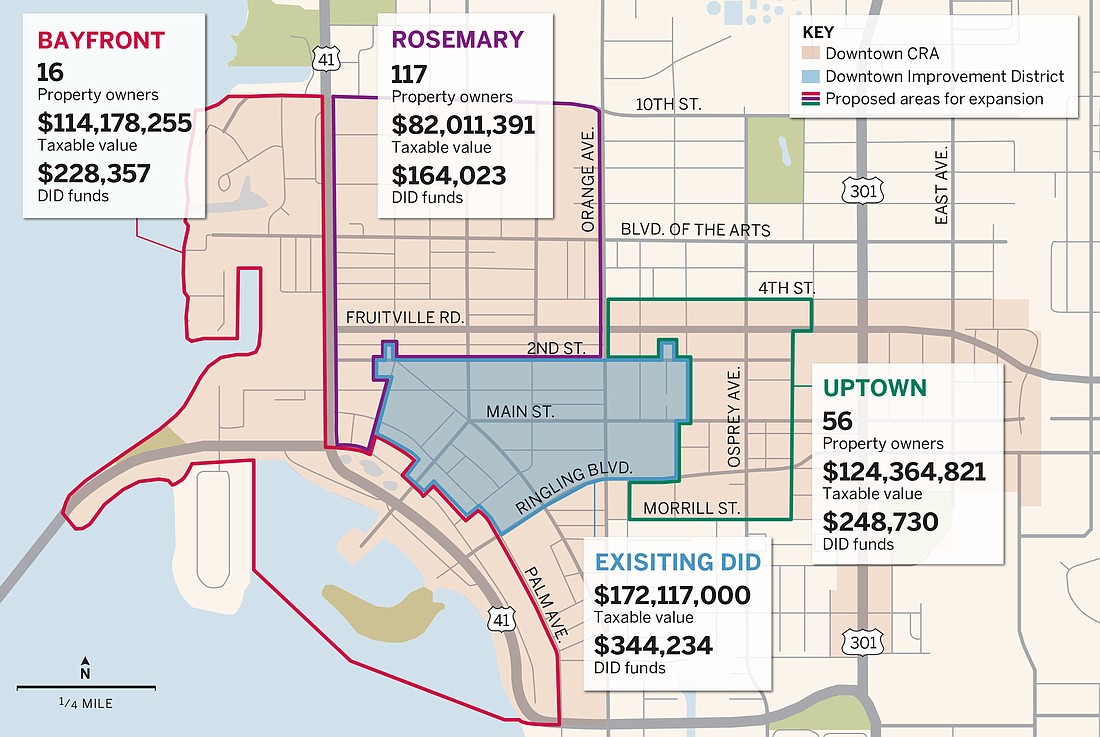- April 25, 2024
-
-
Loading

Loading

In 1999, Ken Shelin was a leading advocate for creating a new mechanism that he believed would spur much-needed activity in the heart of the city. By creating a self-taxing district of commercial property owners, tasked with improving the downtown area, the city could rapidly upgrade its central business hub.
That effort, Shelin says today, was a complete debacle. With leaders unable to wrangle property owners from every corner of downtown, the proposal killed the dream of establishing a business improvement district for nearly a decade. When the City Commission finally established the Downtown Improvement District in 2008 — while Shelin was serving as vice mayor — it was with much smaller boundaries in a more intense commercial segment of the downtown area.
That failure is important to keep in mind, Shelin said, as evidence that the architects of the Downtown Improvement District always favored the idea of incorporating a larger segment of the city.
“We knew if this area succeeded, we could always go back to the City Commission and ask for expansion of the DID,” Shelin said. “I think that’s where we are now.”
Dating back to 2013, the Downtown Improvement District has regularly entertained the notion of expanding its boundaries. But the question of “to where?” always went unanswered. Following the April 28 DID meeting, an answer began to crystalize: The board unanimously voted to investigate expansion east to Links Avenue, north to the Rosemary District, west to the bayfront and to include condominiums within its boundaries.
If incorporated into the district, commercial property owners would be facing a new tax of 2 mills to fund the board’s operating budget. The board indicated they would be willing to tax residential property owners at a lower rate, perhaps 1 mill. Taken together, the three commercial subdistricts could add more than $640,000 to the DID’s current tax income of $345,000.
With the DID short on cash after taking out a bond for a Main Street streetscape improvement project, advocates of expansion said it would have at least two benefits. For the existing board, the newly taxed properties would provide additional resources and allow the DID to take on more significant projects.
Likewise, the new properties incorporated into the DID would have the opportunity to benefit from the same projects that the existing improvement district has seen since 2009. The question for those who favored expansion was one of fit: Who was willing to tax themselves? Which area of the city, if improved, would provide reciprocal benefits for the existing district?
“It’s the greater downtown now. The downtown core and the central business district that we used to have, it’s gone.”
– John Moran, operations manager of the Downtown Improvement District
They may have found an answer in the Rosemary District. Real estate broker Ian Black, a leading advocate for the revitalization of the Rosemary District, and Rosemary District Neighborhood Association President Michael Bush both appeared at April’s DID meeting to signal the area’s desire to become a part of the improvement district.
“I’d like to think there’s close to 100% support for self-taxing ourselves to enable us to take advantage of what we think would be an unprecedented opportunity,” Black said.
Among DID board members, there was some concern that expansion would dilute the effectiveness of spending within the smaller existing boundaries.
“When we bring Rosemary in, at first, there’s going to be a big sucking noise of all of our money going toward Rosemary to subsidize it,” DID board member Ron Soto said.
Advocates for the move, however, argued that an increase in activity within the Rosemary District — and an uptick in residential population there — would have a trickle-down effect on businesses within the existing DID.
“I would hope it sucks some money out and revitalizes it,” board member Steve Seidensticker said. “If it brings business to me, I’m thrilled.”
DID Operations Manager John Moran is heading up a four-person planning group that is investigating the logistics of expanding the DID. He was part of the group that helped establish the DID, a process during which he gathered evidence that land owners who controlled more than two-thirds of the proposed district were in favor of self-taxing. That was enough to sway the commission to put the taxing district in place.
Moran said the planning group would undertake a similar informal surveying effort within the three subdistricts. Already, he’s seen significant interest from the Rosemary District. The bayfront — a potential cash cow, considering the $114 million in taxable values for 16 property owners — is a bigger question mark, with the Ritz-Carlton, Sarasota already signaling some disinterest.
“I’d like to think there’s close to 100% support for self-taxing ourselves to enable us to take advantage of what we think would be an unprecedented opportunity.”
– Ian Black, Rosemary District business owner
Representatives for the Sarasota Downtown Condominium Association have indicated residents would be open to self-taxing given the proper argument in favor of it.
“We would need to have clear, defined benefits,” said Patrick Gannon, president of the condo group. “What’s in it for the residents, presented in a residential point of view.”
Moran’s planning group is looking into the logistics of potential expansion, gathering the areas of improvement prospective new members would like to see addressed. Moran said the original formation of the DID took about a year, but he was hopeful progress might be achieved in half that time for the expansion.
Regardless of where, exactly, the DID’s new boundaries are established, he encouraged the board to think bigger and embrace the possibility of growth.
“It’s the greater downtown now,” Moran said. “The downtown core and the central business district that we used to have, it’s gone.”